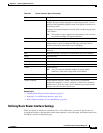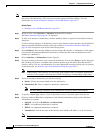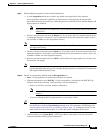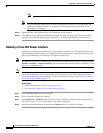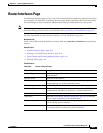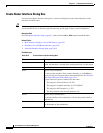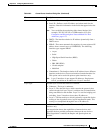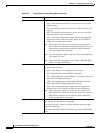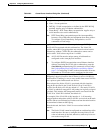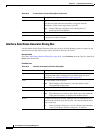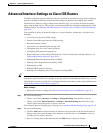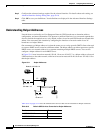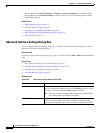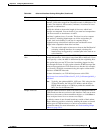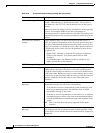
59-11
User Guide for Cisco Security Manager 4.4
OL-28826-01
Chapter 59 Configuring Router Interfaces
Router Interfaces Page
Encapsulation The type of encapsulation performed by the interface:
• None—No encapsulation.
• DOT1Q—VLAN encapsulation, as defined by the IEEE 802.1Q
standard. Applies only to Ethernet subinterfaces.
• Frame Relay—IETF Frame Relay encapsulation. Applies only to
serial interfaces (not serial subinterfaces).
Note IETF Frame Relay encapsulation provides interoperability
between a Cisco IOS router and equipment from other vendors.
To configure Cisco Frame Relay encapsulation, use CLI
commands or FlexConfigs.
VLAN ID Applies only to subinterfaces with encapsulation type DOT1Q.
The VLAN ID associated with this subinterface. The VLAN ID
specifies where 802.1Q tagged packets are sent and received on this
subinterface; without a VLAN ID, the subinterface cannot send or
receive traffic. Valid values range from 1 to 4094.
Note All VLAN IDs must be unique among all subinterfaces
configured on the same physical interface.
Tip To configure DOT1Q encapsulation on an Ethernet interface
without associating the VLAN with a subinterface, enter the
vlan-id dot1q command using CLI commands or FlexConfigs.
See Understanding FlexConfig Policies and Policy Objects,
page 7-2. Configuring VLANs on the main interface increases
the number of VLANs that can be configured on the router.
Native VLAN Applies only when the encapsulation type is DOT1Q and you are
configuring a physical interface that is meant to serve as an 802.1Q
trunk interface. Trunking is a way to carry traffic from several VLANs
over a point-to-point link between two devices.
When selected, the Native VLAN is associated with this interface,
using the ID specified in the VLAN ID field. (If no VLAN ID is
specified for the Native VLAN, the default is 1.) The native VLAN is
the VLAN to which all untagged VLAN packets are logically assigned
by default. This includes the management traffic associated with the
VLAN. If no VLAN ID is defined, the default is 1.
For example, if the VLAN ID of this interface is 1, all incoming
untagged packets and packets with VLAN ID 1 are received on the main
interface and not on a subinterface. Packets sent from the main interface
are transmitted without an 802.1Q tag.
When deselected, the Native VLAN is not associated with this
interface.
Note The Native VLAN cannot be configured on a subinterface of the
trunk interface. Be sure to configure the same Native VLAN
value at both ends of the link; otherwise, traffic may be lost or
sent to the wrong VLAN.
Table 59-3 Create Router Interface Dialog Box (Continued)
Element Description



